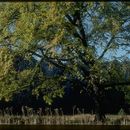en
names in breadcrumbs


Wildlife uses include seed eating by granivorous birds, bird cover, bird nesting sites, and substrate for insectivorous birds. Seeds feed small mammals. It is a larval host for Mourning Cloak (Nymphalis antiopa), Columbia silkmoth (Hyalophora columbia), Question Mark (Polygonia interrogationis), Painted Lady (Vanessa cardui), and Eastern Comma (Polygonia comma). (NPIN, 2008)
USA: AL , AR , CT , DE , FL , GA , IL , IN , IA , KS , KY , LA , ME , MD , MA , MI , MN , MS , MO , MT , NE , NH , NJ , NY , NC , ND , OH , OK , PA , RI , SC , SD , TN , TX , VT , VA , WV , WI , WY , DC (NPIN, 2008)
Canada: MB , NB , NS , ON , PE , QC , SK (NPIN, 2008)
Native Distribution: N.S., s. Man & s.e. Sask. & Crook Co. WY, s. to FL & c. TX (NPIN, 2008)
USDA Native Status: L48(N), CAN(N) (NPIN, 2008)
Flowers are green. (USDA PLANTS, 2009) Flowers are borne in axils on the old twigs. Calyx is bell-shaped and 4-9-lobed. Flowers hang on long drooping pedicels. (Peattie, 1930) Flowers bloom in clusters along the stem. (Hultman, 1978) They have no petals. (Weeks et al, 2005) Bloom color is red or green. (NPIN, 2008) Flowers are born on a shallowly lobed calyx. They are slightly asymmetric, with 7-9 lobes and ciliate margins. There are 7-9 stamens. Anthers are red and stigmas are white-ciliate and deeply divided. (FNA, 2006)
Fruit is brown. (USDA PLANTS, 2009) The samara (winged fruit) is rounded, the wing continuous all around except at the apex. Fruit may be oval or ovate, and is ciliate with fine hairs on the margins. (Peattie, 1930) Single seeds are each surrounded by a papery wing. (Hultman, 1978) Fruit is round and flat with hairy margins. The tip is deeply notched. (Weeks et al, 2005) The fruit is a yellowish to cream samara with narrow wings and hairy edges. Seeds are thick but not inflated. (UW, 2009) Samaras are yellow-cream when mature, though sometimes tinged with reddish purple (particularly in the Southern range of species). They are arrowly winged, with ciliate margins. Cilia are yellow to white. (FNA, 2006)
Leaves are green and coarse. (USDA PLANTS, 2009) Leaves are obovate-oblong and abruptly pointed. Leaves are oval, unequal-sided at the base, and sharply doubly serrate. They are rough above, dull green, and paler below. (Peattie, 1930) Elliptical with a coarsely double-toothed edge, and tapering to a point. (Hultman, 1978) Simple leaves that have a lop-sided base. Fall coloration is yellow. (Weeks et al, 2005) Dark-green leaves have variable fall color. (NPIN, 2008)
Stems This tree has a single stem growth habit. (USDA PLANTS, 2009) Erect arching branches form an umbrella-shaped crown. Twigs and buds are smooth or sparingly pubescent. (Peattie, 1930) Alternate branching is typical. Buds are elongate with chestnut-brown, slightly hairy scales. Twigs zig-zag from node to node. Lateral leaf buds lie against the twig. (Weeks et al, 2005) usually forked into many spreading branches, drooping at ends, forming a very broad, rounded, flat-topped or vaselike crown, often wider than high. (UW, 2009) Old-growth branches are smooth and not winged. Twigs are brown and pubescent to glabrous. (FNA, 2006)
Bark is flaky and gray. (Peattie, 1930) Bark is gray and tough. (Hultman, 1978) Bark is spongy until mature, and is tannish gray with thick, interlacing ridges. Inner bark is two-toned with light and dark layers. It is tan colored and spongy when young. (Weeks et al, 2005)
Tree height at 20 years is a maximum of 50' tall, at maturity 120.0' tall. (USDA PLANTS, 2009) Tree may be 50-100' tall. (Hultman, 1978) The tree was once 100'+ regularly, but is now more commonly 30-40'. (Weeks et al, 2005) It usually grows 60-80'. (NPIN, 2008)
Flowers inflorescence is less than 1" hanging cluster. (UW, 2009) Fascicles are less than 2.5 cm and the pedicel is 1-2 cm. (FNA, 2006)
Fruit is ovate and roughly 1 cm. Cilia to 1 mm. (FNA, 2006)
Leaves 4-6" long. (Hultman, 1978) Petiole is roughly 5 mm. Leaves are 7-14 × 3-7 cm. (FNA, 2006)
Various preparations of bark were used by pregnant women to insure stability of children, for menstrual cramps, for colds, for severe coughs, for dysentery, for "summer disease-vomiting, diarrhea and cramps," to facilitate childbirth and for parturition, for broken bones, for appendicitis, for sore eyes as an eye lotion, for gonorrhea, and for pulmonary hemorrhage. An infusion of root bark was taken for excessive menstruation. Wood was used in various capacities as a structural and vessel building material. (UM, 2009)